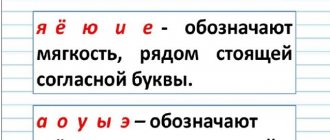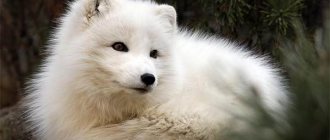Nachalochka
We will not start with vowels and consonants.
First, let’s draw the child’s attention to the fact that there are many different sounds around us: the rustling of leaves, the chirping of birds, the rumble of cars, the creaking of a door, a telephone ringing, etc. At this stage, I offer the child a game: “Guess what sounds.” Let's prepare an “arsenal” of sounding toys. For example, a tambourine, bell, maracas, wooden sticks and even sheets of paper will do. We let the child touch each item, make noise, rattle, rustle with paper, etc. Then we sit with our backs to each other and begin to guess. We definitely change roles. Let's talk with the child about the fact that all objects are made of different materials. That’s why they sound differently: a bell made of metal, sticks made of wood...
But what are the words we pronounce made of?
So we got to the most important thing! And words are made up of sounds. But not from any sounds, but from the sounds of human speech. These sounds arise when the speech organs “work”: tongue, lips, teeth, vocal cords.
And the sounds of human speech are DIFFERENT. If you immediately tell a child that there are vowel and consonant sounds, he simply will not understand anything. If explained using the classical definition, then the child will “go out” altogether.
But I really like one definition of vowels and consonants! And children understand it. So, there are sounds - mouth openers (vowels) and there are sounds - mouth openers (consonants). This definition is easily verified and confirmed. To do this, we pronounce a vowel sound. The child repeats after you. Maybe in front of a mirror. And indeed, the mouth opens, and the louder we pronounce the vowel sound, the more the mouth opens. We pronounce a consonant sound. And then we feel that the mouth is closing, and at the same time the tongue is resting somewhere else, bumping into some obstacles.
We draw the child’s attention to the fact that speech sounds can only be heard and pronounced. They cannot be seen or touched. But speech sounds can be identified. For example, multi-colored squares or circles. You will need squares of red, blue and green colors. Red for vowels, blue and green for consonants. Because consonants are divided into hard and soft.
To indicate these sounds, I used baby puree caps, only those that can easily be connected to each other.
In my classes, these caps play different roles: counting material, multi-colored logical chains, a construction set, a mosaic for the development of logic and fine motor skills. Read more about the caps HERE
One important point!!! Don’t rush to turn sounds into letter icons. Train your child in recognizing different speech sounds (vowels, consonants, hard and soft consonants). This is called phonemic hearing training.
Here are examples:
- Say the sound [a], drawn out, the child repeats; pay attention to how the mouth opens; say with increasing volume and the child repeats again, feeling his mouth opening even more - this is a mouth opener sound, mark it with a red square;
- Say the sound [m], briefly at first; the child repeats after you; then make this sound and the child will follow you; the sound stretches out, but the mouth is tightly closed! Here's a mouth opener for you! We denote it with a blue square.
We continue like this with a few more sounds. We do not touch the vowel sounds that indicate the softness of consonants for now.
Train your child to recognize the first sound in a word.
Example:
- Say the word arch, extending the first sound [a] – aaaaarka;
- What is the first sound in this word? What square will you use to mark it? Why? (questions for the child).
- Say the words machine, extending the first sound [m].
- What is the first sound in this word? What square do you use to mark it with? Why? (questions for the child).
Select words in which the first consonant sounds are [m], [s], [r], [x], [w], [r], [v], [z], [l], [n], [zh] . These sounds, although consonants, are drawn out, so they are easy to distinguish intonationally.
If a child does not yet pronounce a sound correctly, then we do not use it.
We train in recognizing various sound combinations and syllables.
- The fusion of two vowels - [ау], [уа], [ао], [уо], [оу]. We pronounce the sound in a chant. We ask the child:
-What is the first sound? What square will we use?
-What is the second sound? What square will we use?
And here my multi-colored caps are very useful, because they are easily connected, attached to each other, so I can clearly show the child how two sounds are fastened together, connected, merged and they must be pronounced without interruption, so that one sound smoothly transitions into another.
- Merging of vowel and consonant – [am], [us], [ov]…
We highlight each sound in the sound combination, denoting it with squares or pictures (read about the pictures below).
- Merging of consonant and vowel sounds (open syllable) – [ma], [so], [well]…
We select each sound in turn and designate it with a diagram.
- The fusion of three sounds - [sma], [snu], [vso]...
We select each sound in turn, make a diagram using squares or pictures.
- A fusion of three sounds, where an open syllable + a consonant (lock). These are short words of three sounds - [moss], [son], [sleep], [nose], [noise].
- A fusion of 4 sounds, where two open syllables are [mother], [fly], [moon], [owl], [Masha], [Sasha]…
And now about the pictures. I have helpers, fascinators and fascinators. These are multi-colored pictures. Girls are red, boys are blue and green.
There are girls and boys separately. They are used to designate those sounds that do not form sound fusions in a word. This picture needs to be cut so that the boy and girl are separate from each other.
There are two red girls - this is a sound fusion of 2 vowels:
There is a pair where the boy is blue + the girl is red. This is an open syllable where the consonant is hard. These children hold hands and are friends. This means that the sound fusion must be pronounced together, so that the consonant smoothly transitions into a vowel.
Here, to begin with, use sound fusions with those consonants that can be pronounced drawn out [m], [s], [r], [x], [r], [v], [z], [l], [n].
There is a couple where the boy is green and the girl is crimson. The girl was deliberately painted crimson so that the vowel sounds, indicating the softness of consonants, would be visually different from other vowels, indicating the hardness of the consonants.
With the help of these colorful children you can create a diagram of any word.
After such exercises and games for the development of phonemic awareness, I move on to getting acquainted with letters.
And more about this HERE
Similar news on this topic:
- About the letters of vowels and consonants. We learn to read by playing.
- Sound [a], letter Aa.
- How do I use the Reading Toolkit?
- Home school. Materials for preparing for school. Lesson No. 11.
Lesson-fairy tale “The Hedgehog’s Journey” [vowels and consonants]
Depending on the age of the students, this material can be used for different purposes and at different stages of work. So, school-age children can be offered this fairy tale at the stage of familiarization with the concepts of vowel, consonant, voiceless, voiced sound . A fairy tale will help preschoolers generalize ideas on this topic, consolidate terminology, thanks to the plot, figurative comparisons and elements of comic etymology.
If desired, the lesson material can be used in parts (separately vowels and consonants).
The lesson is conducted against the background of a presentation , which includes sound and animation.
Lesson – fairy tale “Journey of the Hedgehog”
Topic: Vowels and consonants.
Goals:
- generalize children’s ideas about vowels and consonants; - consolidate the concepts: vowel, consonant, voiceless, voiced.
Equipment: cut-out alphabet, presentation, sound symbols.
1. Organizational moment
The speech therapist gives the children letters (3 pieces each: 1 vowel, 1 voiced consonant, 1 voiceless consonant) and asks:
- What is this? (Children: - These are letters)
Speech therapist: What is this? Listen: a, o, m, s, i, g? (Children: - These are sounds)
- Read your letters - name the sounds. (Children name their letters)
Speech therapist: - Find its own symbol for each letter. (Children put a red symbol under a vowel, a blue symbol with a bell under a voiced consonant, a blue symbol without a bell under a voiceless letter)
2. Announcing the topic of the lesson.
Today I will tell you a fairy tale about how a hedgehog became acquainted with sounds in his forest. You already know a lot of sounds, so you will help me.
3. Fairy tale.
(Slide 2) A hedgehog lived in one forest. He loved to walk in the forest. One day he walked for a long time and saw a red house.
(Slide 3) Someone was singing in the house. The hedgehog heard a song. (Slide 3 - sound)
- What wonderful sounds! “How they sing!” thought the hedgehog and knocked softly on the door.
The door opened and he was greeted by sound guys in red dresses. (Slide 4 with animation)
“Hello,” they said, “who are you?”
- I am an ordinary hedgehog, my name is Hedgehog, and my last name is Lesnoy. And who are you?
- And we are sounds.
- What is your name?
(By the articulation of vowels, symbolically depicted on the slide, children identify sounds. Each child must name his own sound corresponding to the letter he has. The child names the sound, shows the letter, after which this letter appears on the slide. Children’s response model: “Me name is A")
- Very nice to meet you! - said the Hedgehog.
“And we all have the same last name,” said the sounds.
-Yes? — the hedgehog was surprised, “What is your last name?”
- All of us - ….?" (Children answer “Vowels!”)
- Thank you, vowels, for the song! You sing so well! Can I come to you again?
- We will be very glad!
3. And the hedgehog moved on. Suddenly he sees a blue house standing. (Slide 5) The hedgehog stopped and began to listen. But I didn’t hear the song. But in the house, someone was growling (how? - Children determine the 1st sound in the word “growled”), hissing (how?...), buzzing (how?), snorting (how?..), puffing (how?.. ), grumbled (how?..), grumbled (how?..), wheezed (how?..), mooed (how?..), etc.
(On slide 5 there is an opportunity to demonstrate different sounds by clicking on the speaker images)
Suddenly the door opened and the hedgehog heard:
- Hello! Who are you?
- I am an ordinary hedgehog, my name is Hedgehog, and my last name is Lesnoy. And who are you?
- We are sounds.
- Oh, how many sounds there are in our forest! I won’t remember all of you right away!
- It's nothing! Remember our last names.
And immediately all the sounds scattered in different directions and formed into two columns. Only now the Hedgehog noticed that some (they stood on the left) had bells hanging around their necks, while others (they stood on the right) did not have bells.
The sounds with bells said in chorus:
- Our last name... (Children: - Voiced!)
The sounds without bells also said in chorus, but very quietly:
- Our last name... (Children: - Deaf!)
- And our name is...
And then a terrible noise arose because they all called their names together. (Children pronounce in chorus according to the consonant sound)
- All! All! Quiet! - the hedgehog shouted. But the sounds were noisy. Then the hedgehog shouted: “Quiet! I came up with something! The sounds fell silent, and then they asked in chorus:
- What?
“You need another last name so that it’s immediately clear that you all know how to make noise!” Do you agree?
- Yes! YES! - the sounds screamed. - We agree!
And so they shouted for a long, long time: “We agree! We agree! We agree! We agree! We agree! We agree!”...
“STOP!” shouted the Hedgehog. If you agree, then you CONSENT!
- Hooray!!! We agree! We agree! We agree!
- You will be VOICED CONSONANTS because you have a loud voice, and you will be DEAF CONSONANTS because you have no voice.
- What a long last name! - said one of the sounds.
- You do not like?
- Like! Like! We agree! We agree!
- Oh oh oh! - Hedgehog shouted, - How loud you are! I'll go to another house. Other sounds live there - Vowels. They sing songs, and you just make noise!
“We also want to sing, but we don’t know how,” said those who agreed sadly. Maybe you can come up with something?
- I figured it out! You need to make friends with the vowels and sing together.
- But how? We can't sing!
- And it is not necessary. You will help - pronounce your sounds, and the vowels will sing theirs. Together you get syllables and words. And syllables and words can be pronounced, sung, and even read. Let's go visit the vowels! They will be glad!
And off they went. Along the way, Hedgehog learned the names of sounds and tried to remember which of them was voiced and which was deaf.
- Do you guys remember?
(Slide 6 - with animation)
— Children classify the consonants presented on the slide, and the Speech Pathologist controls the presentation: after each answer, the Speech Pathologist clicks the mouse, and the letter is “sent” to the desired column, which allows children to check the correctness of their answers)
(Slide 7 - with sound)
Speech therapist: - Let's listen to what songs the consonant C made with vowel sounds.
... Let's learn this song.
Notes. Depending on the age of the students, this material can be used for different purposes and at different stages of work. Thus, school-age children can be offered this fairy tale at the stage of familiarization with the concepts of vowel, consonant, voiceless, voiced sound already in the first lessons.
Accordingly, the next stage may be reading words, sound-letter analysis, synthesis of syllables and words, etc.
Pyadysheva Elvira Vladislavovna, teacher-speech therapist, Education Center No. 1429, Moscow
- Speech therapy lesson summary: Vowel sounds and letters
- Presentation “Sounds and Letters”
- Presentation [Exercises for the prevention of acoustic dysgraphia - S-Sh sounds]
- Lesson summary in the first grade for a group of students with functional disabilities - Sounds [S]-[C]
- Summary of an individual speech therapy lesson: Sounds and letters R, L, automation in syllables, words
( 6 liked, average score: 4.83 out of 5)
Loading...






